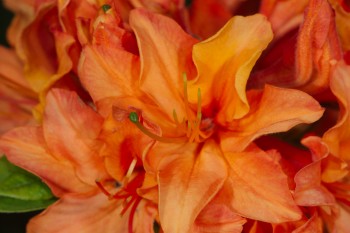Cathy called me today from Home Depot asking if I wanted her to buy this Exbury azalea. I’ve been meaning to get a few of these for the yard and this one was reasonably priced and it good shape, so I said yes. What is an Exbury azalea, you might ask? They have a fairly complicated makeup and many of the early records don’t exist. But in the late 18th century, hybrids were made between North American azalea species Rhododendron calendulaceum, nudiflorum, arborescens, and viscosum, and the bright yellow flowered, European R. luteum, producing what are generally referred to as Ghent azaleas. The addition of R. molle and japonicum took the azaleas to the next stage, the Mollis and then R. occidentale was added, giving us the Knaphill azaleas. Starting in the 1920s Lionel de Rothschild made hundreds of thousands of hybrids and brought us the Exbury azalea. Well, that’s a rather simplified history. You can read more here: http://scholar.lib.vt.edu/ejournals/JARS/v40n1/v40n1-cash1.htm.
Tagged With: Exbury Azalea
Exbury Azalea
Exbury Azalea Buds
The Exbury azalea that Cathy bought for me last year is getting ready to bloom. I planted it near the top of our driveway, to the right where there used to be an awful holly shrub. The deer did some damage to it late last summer but what’s left of it is beginning to come to life. The flower and leaf buds are swelling and there should be some blooms in a few days. The Exbury azaleas are among the deciduous azaleas. In fact, most azalea species are deciduous but since most of us are familiar with azaleas through the proliferation of the Glenn Dale cultivars (developed by Benjamin Morrison from 1935 through 1952), which are evergreen. The Exbury hybrids were made in the 1920s by Lionel de Rothschild and their genetic makeup contains some or all of the following: R. arborescens, R. calendulaceum, R. japonicum, R. luteum, R. molle, R. nudiflorum, R. occidentale, and R. viscosum.
Exbury Azalea
This Exbury azalea is starting to bloom. It’s been eaten back by the deer, so it’s not clear that it will ever get really big unless we are able to protect it. The flowers are quite striking, especially compared to the ubiquitous Glenn Dale azaleas that everyone has. I’ve got nothing against the Glenn Dales, mind you. But you have to admit, they have a certain sameness to them. I suppose if everyone grew Exbury or Mollis azaleas, I’d fell the same way. Or not. They really are spectacular and if you want yellows an oranges, they’re your best bet this time of year. They are deciduous, of course, so if you want leaves year round, they won’t do. But they sure make up for it in bloom.
Exbury Azalea
After work today I sat out in the yard. It was quite warm and I was enjoying the birds singing in the early evening. There is a family of house wrens (Troglodytes aedon) that have nested in a small, ceramic bird house hanging from our cherry tree and they make themselves known. I got a few photos of the wren but they’re small birds and I wasn’t really that close to it. I also surprised a rabbit (an eastern cottontail, Sylvilagus floridanus), who came around the corner and found himself much closer to me that he would have liked. He froze long enough for me to get a pretty good close up. But I decided to post this photo of the Exbury azalea that’s just finishing up a really nice blooming season.




